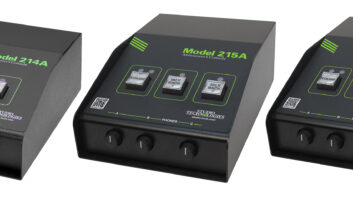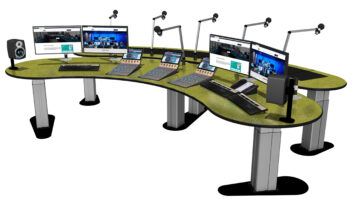The heating, ventilating and air-conditioning (HVAC) requirements of employees and equipment in a sealed space are important considerations in designing a radio or TV station.
The exact air-conditioning load for studio and control room depends on the equipment power consumption and the rate of airflow into the room for a given outside air temperature. Other adverse environmental conditions, such as humidity, also should be factored in.
The design goal of ensuring comfort and safety for employees, along with specific operational challenges such as 24-hour cooling, requires an HVAC system that delivers conditioned air to the studio at a low velocity and distributes it according to convection and diffusion principles.
Good air distribution is also important to ensure that equipment operates at the proper temperature.
Thermal management
In the HVAC system design, special attention should be paid to the issue of thermal management within a studio installation.
Thermal management is not just a matter of introducing cool air to a facility, but also removing the heated air. Simply injecting cooler air does not assure that heated and cooled air will merge and create a desired average temperature.
Due to the laws of physics, pockets of hot air will develop, isolating the cold air from where it is needed and concentrating the heated air into areas where it can do the most harm. These areas are most frequently the equipment racks. Therefore, try to manage a thermal environment, not to fight it.
The issue has gained special importance over the past two decades, with the introduction of personal computers and other digital equipment sensitive to dust and humidity. Consequently, air filters are now found not only within the air conditioning system, but also at the air inlets of sensitive units of equipment.
Passive or active
There are two primary approaches to thermal management: passive and active. Passive solutions make the most out of venting and understanding the behavior of heat to maximize the efficiency of vents. Active solutions are based on designing fans to move air in a predetermined path.
A good approach to thermal system design means resolving two airflows: 1) the way heated air travels through the equipment rack and 2) the path of the air throughout the room. These two airflows will interact. It is up to the design of the thermal management system to assure that all heat generated by equipment is first removed from the rack and eventually from the room.
Knowing that there are many radio stations around the world that do not have air-conditioned environments, it is important to fulfill at least the minimum requirements for venting the rooms to assure that heat from the racks does not raise significantly the ambient temperature.
Many radio professionals believe that studios and control rooms should be no hotter than 24°C (75°F), while internal rack temperature should not exceed 30°C (86°F). The latter figure is important to assure proper equipment function and longevity. For every 10°C (18°F) increase above 20°C (68°F) long-term reliability of studio equipment is reduced by 50 percent.
Hot spots
Proper planning of airflow inside a rack ensures that the waste heat is effectively removed and no hot spots occur.
When the cooler air is taken from the front and the heated air exhausted toward the rear or sides of the cabinet, this is known as front-intake equipment. In opposite case, when the cooler air is taken from the rear and the heated air exhausted toward the front of the cabinet, this is known as rear-intake equipment.
In both cases, the largest heat load will come from power amplifiers. Hence, the amplifiers and other hotter equipment should be placed in the lowermost part of the rack. This approach helps the natural convective rise of heat.
Experience shows that moving air through a rack from bottom to top results in the lowest internal temperatures. Passive convection of heated air (without fans) will benefit also from the largest racks. Wider racks assure a good chimney effect by drawing heat upward more effectively.
To create an unimpeded airflow inside the rack, the vent openings should be at the bottom and the top of the rack, never at the middle. Also, care should be taken when equipment is stacked directly on top of one other, in order not to block the intake vents on the bottom and the exhaust vents at the top of the unit.
A lot of equipment has internal fans. The air exhausted by internal fans will cause the recirculation of the rack air and may disturb the natural convective rise of heat. A similar problem may arise if the rack is placed directly under supply ductwork. Cold air falls and goes in the opposite direction to the natural convective rise of heated air.
When too many pieces of hot equipment are within a rack, passive thermal management is not a solution, and it becomes essential to force heated air from the rack. This is active thermal management. It means that fans are used to remove heat from an equipment rack.
The best spot for fan placement is in the top of the rack, where the hot air is concentrated and needs to be removed. Vertical placement of fans is appropriate where there is possibility of contaminants falling into the rack.
The use of multiple fans requires that they be checked regularly for proper operation. If one fan stops functioning, it acts as a passive vent, i.e., a short-circuit path for the airflow. A nearby fan or fans which are still functioning will not effectively remove heat from the rack due to this short-circuit path.
Similarly, place vent blockers over all intake points close to the fan and at other positions except at the top of the rack.
Proper fan and vent placement helps force more air into the rack, and assures correct airflow to break up eventual hot spots.
The same approach applies for shelves within a rack. Shelf surfaces are an obstruction to airflow. To prevent a temperature rise in the lower parts of the rack, shelves have to be vented. In general, more open area in the form of slots or perforations on a shelf surface is always better.
Fan performance
When it comes to the choice of fans, two terms are essential for describing and understanding their performance: airflow rate and static pressure.
Airflow rate is the volume of air (in cubic meters) moved per minute. The airflow rate of fan (or fans) at the top of the rack has to be greater than the sum of airflow rates of all the fans built into the equipment within the rack.
Static pressure is the pressure or suction the fan is capable of developing. As the air travels through intake vents, the air pressure drops. The fan selected must be capable of operating at a given static pressure, as a measurement of resistance to airflow. Otherwise, the airflow rate will drop.
A proper use of fan(s) at the top of the rack, in combination with the equipment’s built-in fans, will increase the static pressure. The air will be pulled through the vents more effectively when both the rack and units’ fans work together as a team.
Dust and humidity
In a humid environment, generally an area with a relative humidity of 70 percent or greater, dust will absorb the air moisture. The result is increased accumulation of dust on equipment circuit boards.
All sensitive digital equipment and PCs will be affected unless proper air filtration is used. Filters on the air conditioning system and within the equipment have to be cleaned regularly.
Along with filters, another systematic measure will help prevent equipment failure: the proper use of the fan’s speed control. A general rule is that the lower fan speeds have the effect of decreasing the amount of deposited dust. If dust is deposited on circuit boards inside the equipment, it will further reduce its thermal transfer, resulting in shorter life-time and potential malfunctioning of sensitive equipment.
Noise aspects
Noise is another important consideration with air-conditioning and active thermal management of studio installations.
Structure-borne noise is produced by the vibrations of the HVAC motor, fan and compressor — the same as from any machine. Aerodynamic noise is produced by the air flow in the ducts and through grilles and diffusers.
Transmission of these noises from air-conditioning system via the ductwork to all studio facilities is a major problem. Hence, correct planning at an early stage will save costly modifications later on.
The designers of an HVAC system should cooperate closely with the acoustics consultant and provide sound silencers and acoustical lining in the ductwork, if necessary, to meet studio noise criteria.
Noise transmitted through air-conditioning ducts must be attenuated before it enters critical studio areas, i.e., the passage of sound from one place to another must be prevented or at least reduced to an acceptable level. The use of fans with the capability of precise, dynamic control of the variable-frequency drive allows us to vary the fan speed and the air velocity in order to minimize the transfer of sound and vibration.
Furthermore, to meet noise criteria, the required slow-speed airflow is achieved by increasing the cross-sectional area requirements for ductwork and grilles, while the exit velocity at the diffuser of the air-conditioning system is reduced. Low-velocity air supply helps to eliminate noise caused by turbulence in the duct and grille.
Typical design requirements are 1 meter per second for grille velocity and 10 changes of air per hour for medium-sized studio facilities.
Some radio and TV broadcasting studios and control rooms have additional, separated technical equipment facilities, called machine rooms or central technical areas.
Good air distribution and thermal management are also important for these facilities to maintain the equipment at the proper temperature.
Blažo Guzina, M.Sc., Dipl.-Ing., is a senior engineer within the Technical Department of Radio-Televizija Srbije. He is the author of the Serbian-language books “Sound Recording Technique” and “Audio Techniques in Radio and Television.” Contact him via e-mail at[email protected].











